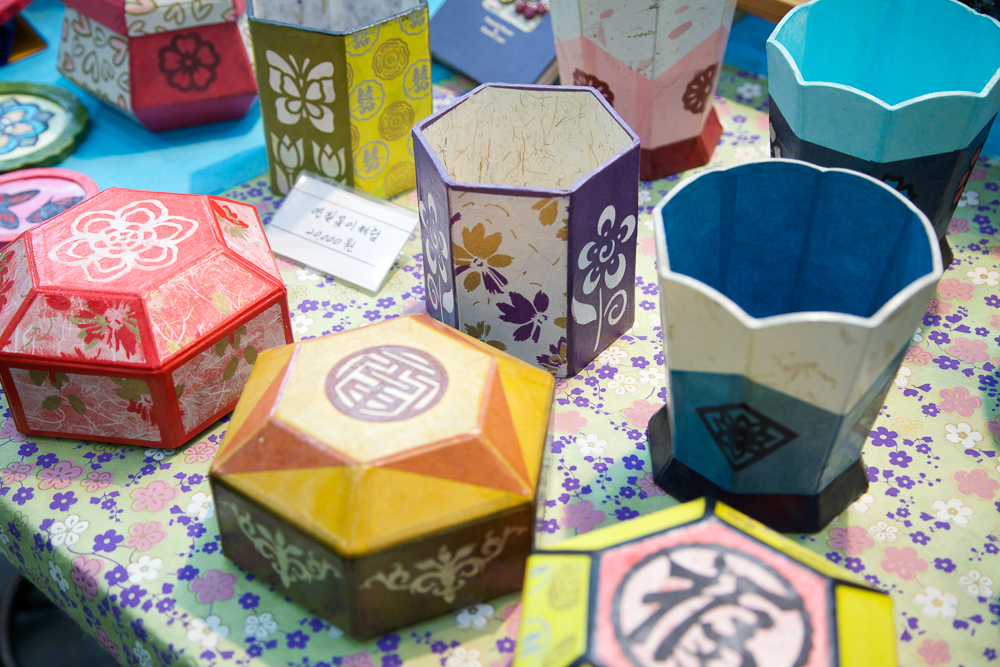Located between the Five Grand Palaces of Korea, Insadong is a must-visit neighborhood during your vacation in Seoul. Historically the main street was inhabited by the arts and traditional culture. In the past decade, commercial businesses have trickled in, driving up rent prices. Skin care shops are turning Insadong into Skin-sadong! A handful of long-standing souvenir shops remain. Here are the top activities to partake in as you stroll down Insadong Street:
1. SOUVENIR SHOPPING
On the main street and in alleyways are shops selling specialized goods, including pottery, hanbok (traditional Korean clothing), and hanji (traditional handmade paper). Souvenir shops carry an assortment of standard Korean utensils, calligraphy materials, figurines, as well as tacky touristy goods.
Crates of assorted ceramics found at Insadong.
Utensils of the Korean people: metal chopsticks and spoons.
Pick up sets of kitchenware for your family and friends back home! Just remember to take off the price tag :)
2. EAT KOREAN FEASTS (HAN JEONG SHIK)
Rule of thumb: come to Insadong Street with an empty stomach. Restaurants such as Hanul Poong-Kyung offer dishes such as ginseng chicken with black rice, mung-bean jelly with beef and vegetables, soybean paste stew, abalone, natural pine mushrooms, various types of kimchi and more!
Korean feast at Hanul Poong-Kyoung.
Natural Pine Mushroom at Hanul Poong-Kyung.
3. VISIT ART GALLERIES
With rotating exhibitions, soak in the paintings and sculptures while you can. Get lucky and you just might meet the artist themselves! They may be tending the floor where their work is being displayed.
Ceramic piece by Jeon Changhyun.
Gana Art Space at Insadong.
4. EXPLORE THE TWISTING ALLEYS
Sure, it can be plenty of fun walking on Insadong's main street, but wait until you venture into the hidden alleys. From traditional tea houses to affordable Korean food to makeolli drinking, you'll want to come back again and again to try every hidden gem. These alleys may get busy during lunch hours, but makes for a meditative stroll when the calm sets back in. Observe. Chefs lay out their ingredients to dry under the sun while cats take a nap like it's a lazy Sunday afternoon.
A typical alley at Insadong is filled with food, food and more food.
Halved eggplants tanning. Visit on a dry day and you'll find restaurants laying out their ingredients under the sun.
Kitty sighting in an alley. Baby Meow drinking its mama's milk.
5. GO ON A HANBOK PHOTOSHOOT
Grab your friends and get traditional! Ladies, dress up like a queen, princess or gisaeng (old-school entertainers). Gentlemen, be a king or warrior for the day. Even get your makeup and hair done at select hanbok studios.
Professor Oh (me), Yoonah and Judy dressed in hanbok at Goguan Studio.
I share my hanbok photoshoot experience with you in KWOW episode 130.
6. EAT STREET FOOD
As long it's not raining, street food vendors come out to serve their specialties. From spicy rice cakes to saxophone-shaped ice cream cones, you'll leave the street with a full tummy. Watch their cooking and try to mimic the steps in your own kitchen!
Man grilling skewers of octopus on a winter day at Insadong.
Lady in hanbok making Korean crackers during autumn.
7. HANG OUT AT SSAMZIGIL
A spiraling four-story building of arts, crafts, shopping and food, Ssamzigil will fulfill your appetite for all things cute and colorful. Head to the basement for workshops where you can paint on pottery and purchase handmade goods. The top floor hosts a cafe and an area where you stick lovey-dovey messages on walls.
Crafts and handmade goods found at the basement of Ssamzigil.
Rooftop of Ssamzigil. Write messages on circles and fasten them on the walls. A fun activity for you and your love!
8. RELAX AT A CAFE
A rainy day in Insadong? Street food vendors might've taken a day off, but some cafes will give you a discount for the wet weather! Most spots provide dependable Wifi as the majority of cafes in Seoul do.
Jars of tea inside the famously long-titled cafe called "Moon Bird Does Thinks of Only the Moon."
Handful of cafes in Insadong allow customers to write on their walls.
Traditional Korean desserts enjoyed at "Moon Bird Does Thinks of Only the Moon" cafe.
The older traditional cafes are hidden in alleys as the commercial cafes dominate Insadong Street.
Watch the KWOW episode on Insadong if you haven't already (below)!






































